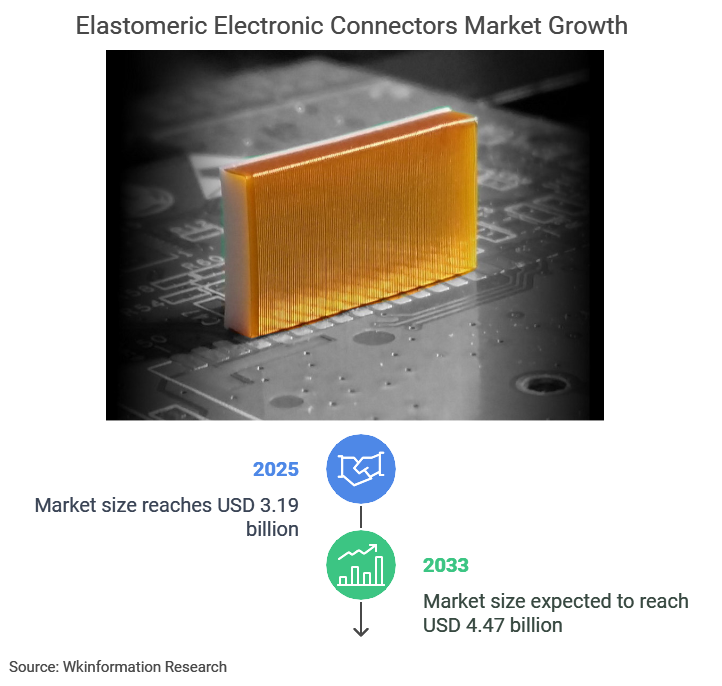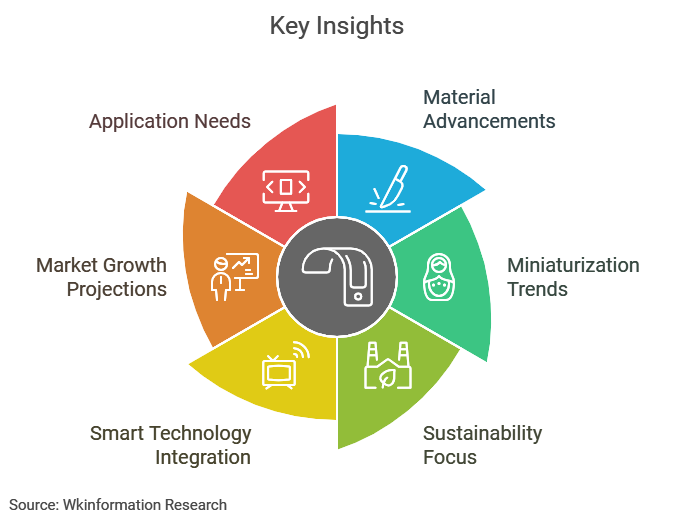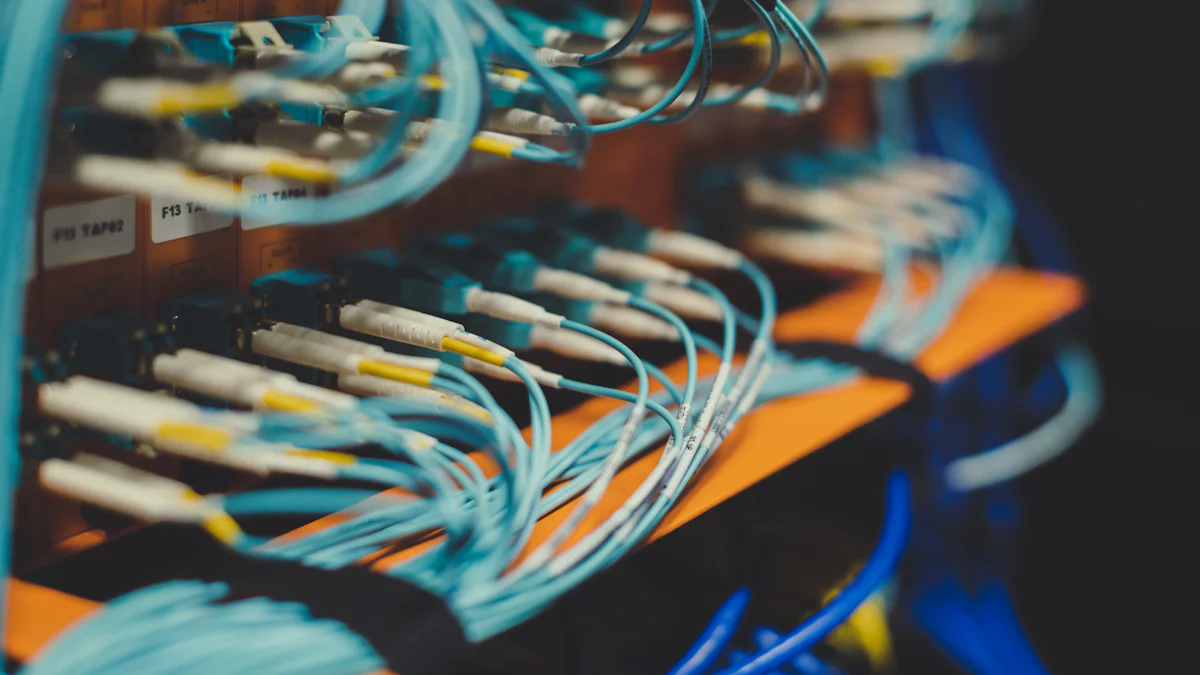
Elastomeric electronic connectors play a pivotal role in modern technology by ensuring flexible and dependable connections across diverse industries. Their unique ability to withstand vibration, shock, and temperature variations makes them indispensable in applications ranging from consumer electronics to automotive systems. These connectors not only enhance device performance but also support the miniaturization of electronics, meeting the growing demand for compact and efficient designs. The market size will reach USD 3.19 billion in 2025 and is expected to reach USD 4.47 billion by 2033, with a CAGR of 4.31% from 2025 to 2033. As industries continue to innovate, the elastomeric electronic connectors market remains a cornerstone for enabling reliable signal and power transmission in next-generation devices.
Key Insights
- Elastomeric connectors are essential for modern technology, providing flexible and reliable connections across various industries, including automotive and consumer electronics.
- The market is witnessing significant advancements in material science, leading to the development of high-performance elastomeric connectors that enhance durability and reduce maintenance costs.
- Miniaturization trends are driving the demand for compact elastomeric connectors, enabling seamless integration into sleek electronic devices like smartphones and wearables.
- Sustainability is a key focus, with manufacturers adopting eco-friendly materials and processes to minimize environmental impact and reduce electronic waste.
- The integration of smart technology into elastomeric connectors allows for real-time monitoring and IoT compatibility, enhancing their functionality in advanced applications.
- The elastomeric connectors market is projected to grow at a CAGR of 4.31%, reaching approximately $4.47 billion by 2033, driven by the demand for advanced electronics and sustainable solutions.
- Choosing the right elastomeric connector involves evaluating specific application needs, including electrical conductivity and environmental conditions, to ensure optimal performance.

Market Trends in the Elastomeric Electronic Connectors Market

Technological Advancements
Development of high-performance materials for enhanced durability.
The elastomeric electronic connectors market has witnessed significant progress in material science. Manufacturers now utilize high-performance materials that enhance durability and operational efficiency. These materials resist wear and tear, ensuring reliable performance even in harsh environments. Industries such as automotive and aerospace benefit from these advancements, as connectors can withstand extreme temperatures, vibrations, and shocks. This durability reduces maintenance needs, leading to lower long-term costs and improved safety standards.
Miniaturization of connectors to meet compact device requirements.
The demand for smaller, more efficient electronic devices has driven the miniaturization of elastomeric connectors. Compact connectors enable seamless integration into modern gadgets like smartphones, wearables, and medical devices. Their ability to maintain high current-carrying capacity and low contact resistance, despite their reduced size, makes them indispensable. This trend supports the development of lightweight and portable technologies, aligning with consumer preferences for sleek and efficient designs.
Sustainability in Manufacturing
Adoption of eco-friendly materials and processes.
Sustainability has become a core focus in the elastomeric electronic connectors market. Manufacturers increasingly adopt eco-friendly materials and processes to minimize environmental impact. By using recyclable components and reducing hazardous substances, companies align with global sustainability goals. These practices not only reduce electronic waste but also appeal to environmentally conscious consumers and industries.
Focus on reducing electronic waste through recyclable components.
Recyclable components play a pivotal role in addressing the growing issue of electronic waste. Elastomeric connectors designed with sustainability in mind contribute to a circular economy. They allow for easier disassembly and recycling at the end of a product’s lifecycle. This approach not only conserves resources but also reduces the environmental footprint of electronic devices.
Integration of Intelligent Solutions
Smart connectors with embedded sensors for real-time monitoring.
The integration of smart technology has revolutionized the functionality of elastomeric connectors. Embedded sensors enable real-time monitoring of performance metrics, such as temperature and electrical conductivity. These features enhance reliability by providing predictive maintenance capabilities. Industries like industrial automation and automotive leverage these smart connectors to prevent downtime and ensure optimal performance.
IoT-enabled connectors for advanced connectivity.
The rise of the Internet of Things (IoT) has further expanded the applications of elastomeric connectors. IoT-enabled connectors facilitate advanced connectivity between devices, enabling seamless communication in complex systems. This innovation supports the development of smart homes, autonomous vehicles, and connected healthcare solutions. The flexibility and reliability of these connectors make them ideal for IoT applications, driving their adoption across various sectors.
Market Segmentation in the Elastomeric Connectors Market
Market segmentation provides a comprehensive understanding of the elastomeric electronic connectors market by categorizing it into distinct groups. This approach highlights the diverse applications, product types, and geographical regions that shape the market dynamics.
By Type
Conductive elastomeric connectors
Conductive elastomeric connectors serve as essential components in industries requiring efficient electrical conductivity. These connectors utilize high-performance elastomers embedded with conductive materials, ensuring reliable signal transmission. Their applications span consumer electronics, automotive systems, and industrial machinery. The demand for these connectors continues to grow due to their ability to maintain performance under extreme conditions, such as high temperatures and vibrations.
Non-conductive elastomeric connectors
Non-conductive elastomeric connectors cater to applications where insulation and mechanical flexibility are critical. These connectors, made from high-performance elastomers, provide robust physical connections without conducting electricity. Industries like medical devices and aerospace rely on these connectors for their durability and adaptability. Their role in ensuring safety and structural integrity makes them indispensable in sensitive environments.
By Application
Consumer electronics (smartphones, wearables, etc.)
The consumer electronics sector represents a significant segment of the elastomeric electronic connectors market. Devices like smartphones, wearables, and tablets require compact and flexible connectors to support their sleek designs. High-performance elastomers enable these connectors to withstand repeated usage while maintaining functionality. The growing adoption of smart devices drives the demand for innovative connector solutions in this segment.
Automotive (electric vehicles, infotainment systems, etc.)
The automotive industry heavily relies on elastomeric connectors for applications in electric vehicles, infotainment systems, and advanced driver-assistance systems (ADAS). These connectors ensure reliable performance in harsh automotive environments, including exposure to heat, vibration, and moisture. The shift toward electric and autonomous vehicles further amplifies the need for durable and efficient connectors.
Industrial (automation, robotics, etc.)
Industrial applications, including automation and robotics, demand connectors capable of withstanding rigorous operational conditions. Elastomeric connectors, made from high-performance elastomers, provide the necessary durability and flexibility. Their ability to maintain performance in dynamic environments makes them ideal for industrial machinery and robotic systems. The rise of Industry 4.0 and smart factories fuels the growth of this segment.
Medical devices (diagnostic equipment, implants, etc.)
In the medical field, elastomeric connectors play a crucial role in diagnostic equipment, implants, and wearable health devices. These connectors ensure reliable connections while meeting stringent safety and hygiene standards. High-performance elastomers used in these connectors provide biocompatibility and resistance to sterilization processes. The increasing demand for advanced medical technologies drives innovation in this segment.
By Geography
North America
North America holds a prominent position in the elastomeric electronic connectors market. The region’s strong demand stems from industries such as automotive, aerospace, and consumer electronics. Technological advancements and the presence of key market players contribute to the region’s growth.
Europe
Europe represents a significant market for elastomeric connectors, driven by its robust automotive and industrial sectors. The region’s focus on sustainability and eco-friendly manufacturing practices aligns with the adoption of recyclable components in connectors. This emphasis on green technology supports market expansion.
Asia-Pacific
Asia-Pacific emerges as a rapidly growing market due to its thriving electronics and automotive industries. Countries like China, Japan, and South Korea lead in manufacturing and innovation. The region’s increasing investments in IoT and smart technologies further boost the demand for elastomeric connectors.
Rest of the World
The Rest of the World segment encompasses regions with emerging markets, including Latin America, the Middle East, and Africa. These regions witness steady growth due to rising industrialization and technological adoption. The demand for elastomeric connectors in these areas reflects the global expansion of various industries.
Competitive Landscape of the Elastomeric Electronic Connectors Market
Key Players and Their Market Presence
Overview of leading companies in the market.
The elastomeric electronic connectors market features a diverse array of key players, each contributing to its growth and innovation. Companies such as Fujipoly, TE Connectivity, and Shin-Etsu lead the industry with their advanced product offerings and extensive expertise. These organizations focus on delivering high-quality connectors that meet the demands of various industries, including automotive, consumer electronics, and industrial automation. Other notable contributors include Sekisui Chemical, Glory Sun Group, and Z-Axis Connector, which emphasize material innovation and manufacturing efficiency.
Smaller yet impactful players, such as Adkom Elektronik, You Eal, and Ruter Elastomer, also play a significant role in shaping the market. Their specialized solutions cater to niche applications, ensuring a competitive and dynamic environment. The presence of these companies highlights the market’s adaptability and capacity for addressing diverse customer needs.
Regional and industry-specific footprints of key players.
Key players maintain strong regional and industry-specific footprints, reflecting their strategic focus on targeted markets. Fujipoly and Shin-Etsu dominate the Asia-Pacific region, leveraging the region’s robust electronics manufacturing sector. Their operations align with the growing demand for compact and efficient connectors in countries like China, Japan, and South Korea. In North America, TE Connectivity leads with its emphasis on automotive and aerospace applications, addressing the region’s advanced technological requirements.
European companies, such as Sekisui Chemical, prioritize sustainability and eco-friendly manufacturing practices, aligning with the region’s stringent environmental regulations. Meanwhile, emerging markets in Latin America, the Middle East, and Africa witness increasing activity from players like Glory Sun Group and Zebra Technical, which aim to capitalize on rising industrialization and technological adoption.
Innovations and Strategies
New product launches and technological advancements.
Innovation drives the competitive landscape of the elastomeric connectors market. Leading companies consistently introduce new products to address evolving customer demands. For instance, TE Connectivity has developed connectors with enhanced durability and miniaturization capabilities, catering to the growing trend of compact electronic devices. Similarly, Fujipoly focuses on high-performance materials that improve thermal and electrical conductivity, ensuring reliable performance in extreme conditions.
Technological advancements also play a pivotal role in maintaining competitiveness. Companies like Shin-Etsu and Sekisui Chemical invest heavily in research and development to create connectors with smart features, such as embedded sensors and IoT compatibility. These innovations enhance functionality and expand the scope of applications, particularly in industrial automation and connected healthcare.
Strategic partnerships and acquisitions to expand market reach.
Strategic collaborations and acquisitions serve as key drivers of market expansion. Companies form partnerships to leverage complementary strengths and access new markets. For example, Glory Sun Group collaborates with regional distributors to strengthen its presence in emerging economies. Similarly, Adkom Elektronik partners with technology firms to integrate advanced features into its product portfolio.
Acquisitions further enhance market positioning by enabling companies to diversify their offerings and enter untapped segments. TE Connectivity has acquired smaller firms specializing in niche applications, broadening its product range and customer base. These strategies not only boost competitiveness but also ensure long-term growth in a rapidly evolving market.
Elastomeric Connectors Market Size and Forecast

Current Market Size
Data on the current valuation of the global market.
The elastomeric connectors market size and forecast reflects a dynamic and growing industry. In 2025, the global market reached an estimated valuation of $3.19 billion. This figure highlights the increasing demand for elastomeric connectors across various industries, including automotive, consumer electronics, and industrial applications. The market’s robust growth stems from advancements in technology and the rising adoption of compact, high-performance devices.
Breakdown of market share by type, application, and region.
A detailed analysis of the market size and forecast reveals significant segmentation by type, application, and geography. Conductive elastomeric connectors dominate the market, accounting for a substantial share due to their widespread use in electronic devices and automotive systems. Non-conductive elastomeric connectors also hold a notable portion, driven by their critical role in medical devices and aerospace applications.
From an application perspective, consumer electronics lead the market, fueled by the proliferation of smartphones, wearables, and other portable devices. The automotive sector follows closely, with electric vehicles and advanced driver-assistance systems (ADAS) driving demand. Industrial automation and medical technologies further contribute to the market’s expansion.
Geographically, Asia-Pacific emerges as the largest contributor to the elastomeric connectors market size and forecast, supported by its thriving electronics manufacturing sector and increasing investments in IoT technologies. North America and Europe also hold significant shares, driven by advancements in automotive and industrial applications. Emerging markets in Latin America, the Middle East, and Africa show steady growth, reflecting rising industrialization and technological adoption.
Growth Projections
Expected CAGR and market size by 2033.
The elastomeric connectors market size and forecast projects a compound annual growth rate (CAGR) of 4.31% from 2025 to 2033. By 2033, the global market is expected to reach approximately $4.47 billion. This growth underscores the increasing reliance on elastomeric connectors to meet the demands of modern electronic applications. The market’s expansion aligns with the rising adoption of advanced technologies and the need for reliable, flexible connections.
Key factors driving growth, including demand for advanced electronics and sustainability initiatives.
Several factors drive the growth of the elastomeric connectors market size and forecast. The demand for advanced electronics, such as IoT-enabled devices and smart technologies, plays a pivotal role. Miniaturization trends in electronic devices further amplify the need for compact and efficient connectors. Additionally, the rise of electric vehicles and infrastructure development contributes to the market’s upward trajectory.
Sustainability initiatives also influence the market’s growth. Manufacturers increasingly adopt eco-friendly materials and processes, aligning with global efforts to reduce electronic waste. The focus on recyclable components and sustainable manufacturing practices enhances the market’s appeal to environmentally conscious industries and consumers.
The elastomeric connectors market size and forecast reflects a promising future, driven by technological advancements, evolving consumer needs, and sustainability efforts. As industries continue to innovate, the market’s growth potential remains significant, offering opportunities for stakeholders across the value chain.
Overview
The elastomeric electronic connectors market demonstrates remarkable potential, driven by evolving market dynamics and technological advancements. A detailed analysis of trends reveals significant market opportunities across diverse applications, including consumer electronics, automotive, and medical devices. The segmentation insights highlight the growing demand for compact, durable, and sustainable solutions. Competitive market dynamics showcase innovation and strategic collaborations as key growth drivers.
The market outlook emphasizes robust growth rates, with industries leveraging these connectors to meet modern demands. As innovation and sustainability continue to shape the landscape, stakeholders can capitalize on future market opportunities to achieve long-term success.
| Report Attributes | Details |
|---|---|
| Base Year | 2024 |
| Market Size 2025 | 3.19 Billion USD |
| Market Size 2033 | 4.47 Billion USD |
| CAGR | 4.31% |
| Historical Year | 2019 – 2024 |
| Forecast Year | 2025 – 2033 |
| Report Coverage | Revenue Forecast, Market Competitive Landscape, Growth Factors, and Trends |
| Segments Covered | Type, Applications, and Region |
| Geographies Covered | North America, Europe, Asia Pacific, and the Rest of the World |
FAQ
What are elastomeric connectors, and why are they important?
Elastomeric connectors are flexible components designed to establish reliable electrical connections in various devices. Their unique silicone-based structure ensures durability, water resistance, and adaptability to different environments. These connectors play a critical role in industries like automotive, medical, and consumer electronics by providing dependable performance under challenging conditions, such as extreme temperatures or vibrations.
How do elastomeric connectors differ from traditional mechanical connectors?
Elastomeric connectors offer distinct advantages over mechanical connectors. Their silicone base provides superior water tightness, achieving high IP ratings against fluids and particles. Unlike mechanical connectors, elastomeric options allow for greater customization, enabling integration into high-density contact point configurations. This flexibility makes them ideal for applications requiring precision and reliability, such as medical devices and compact electronics.
Can elastomeric connectors be customized for specific applications?
Yes, elastomeric connectors can be tailored to meet specific application requirements. Manufacturers design these connectors based on the desired configuration, ensuring compatibility with the electronic assembly’s components. Customization options include integrating connectors into frames for enhanced functionality or optimizing designs for high-density contact points. This adaptability makes them a strategic choice for industries with unique demands.
“Customization ensures that elastomeric connectors meet the exact needs of each application, enhancing their versatility and effectiveness.”
What industries benefit the most from elastomeric connectors?
Several industries rely heavily on elastomeric connectors due to their unique properties. Key sectors include:
- Automotive: Used in electric vehicles, infotainment systems, and advanced driver-assistance systems.
- Medical: Essential for diagnostic equipment, implants, and wearable health devices.
- Consumer Electronics: Found in smartphones, wearables, and other compact devices.
- Industrial Automation: Applied in robotics and machinery requiring durable and flexible connections.
These connectors address the specific challenges of each industry, ensuring optimal performance and reliability.
How do elastomeric connectors contribute to sustainability?
Elastomeric connectors support sustainability through the use of eco-friendly materials and recyclable components. Manufacturers focus on reducing electronic waste by designing connectors that can be easily disassembled and recycled. This approach aligns with global sustainability goals, promoting a circular economy and minimizing environmental impact.
Are elastomeric connectors suitable for harsh environments?
Yes, elastomeric connectors excel in harsh environments. Their high-performance materials withstand extreme temperatures, vibrations, and shocks, making them ideal for automotive, aerospace, and industrial applications. These connectors maintain their functionality and reliability even under demanding conditions, ensuring long-term performance and safety.
How does one select the right elastomeric connector for an application?
Choosing the appropriate elastomeric connector involves evaluating the application’s specific requirements, such as electrical conductivity, environmental conditions, and mechanical flexibility. Consulting with manufacturers or industry experts can help identify the best solution tailored to the device’s needs. Factors like size, material composition, and customization options play a crucial role in the selection process.
What advancements have been made in elastomeric connectors?
The elastomeric connectors market has seen significant advancements, including:
- Miniaturization: Development of compact connectors for modern electronic devices.
- Smart Features: Integration of sensors for real-time monitoring and IoT compatibility.
- Material Innovation: Use of high-performance materials for enhanced durability and conductivity.
These innovations address evolving industry demands, ensuring that elastomeric connectors remain at the forefront of technological progress.
How does the elastomeric connectors market forecast look?
The elastomeric connectors market is projected to grow steadily, with a compound annual growth rate (CAGR) of 4.31% from 2025 to 2033. By 2033, the market is expected to reach approximately $4.47 billion. This growth reflects increasing demand across industries, driven by advancements in technology, sustainability initiatives, and the rising adoption of compact and efficient devices.
Why are elastomeric connectors a strategic choice for medical applications?
Elastomeric connectors are highly valued in medical applications due to their biocompatibility, water resistance, and ability to meet stringent hygiene standards. Their silicone base ensures a high level of water tightness, making them suitable for sterilization processes. Additionally, their customizable design allows for precise integration into medical devices, ensuring reliable performance in critical healthcare settings.
Global Elastomeric Electronic Connectors Market Report – Table of Contents
1 Market Study Overview
2 Basic Product Information
3 Market Analysis
4 Elastomeric Electronic Connectors Related Market Analysis
5 Global Trend Summary
6 Competition by Manufacturer
7 Analysis of Key Players
8 Global Elastomeric Electronic Connectors Revenue, Sales Categorized by Regions
9 North America Elastomeric Electronic Connectors Market Size Categorized by Countries
10 Europe Elastomeric Electronic Connectors Market Size Categorized by Countries
11 Asia-pacific Elastomeric Electronic Connectors Market Size Categorized by Countries
12 South America Elastomeric Electronic Connectors Market Size Categorized by Countries
13 Middle East and Africa Elastomeric Electronic Connectors Market Size Categorized by Countries
14 Global Elastomeric Electronic Connectors Industry Segment Analysis
15 Global Elastomeric Electronic Connectors Market Forecast
16 Research Findings and Conclusion
17 Appendix



